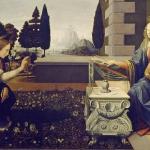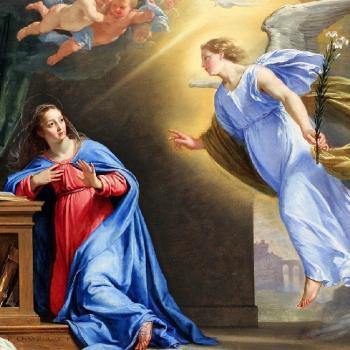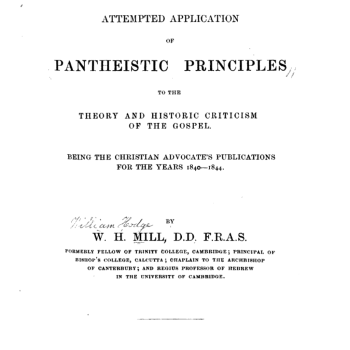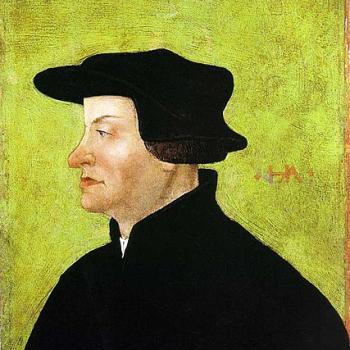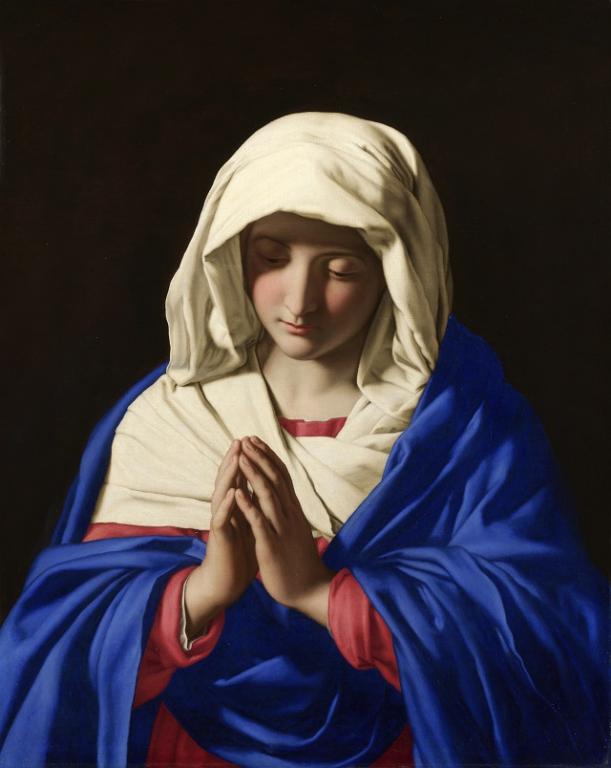
The following is a compilation of some of the more explicit patristic, medieval, and post-Renaissance statements of Fathers, Doctors, and other eminent theologians, on the subject of Mary as Mediatrix of all Graces, Advocate, and Co-Redemptrix. Vatican II, papal encyclicals, and the Catechism of the Catholic Church are also cited.
Sources Used
St. Alphonsus de Liguori, The Glories of Mary, Brooklyn: Redemptorist Fathers, 1931 edition.
C. X. J. M. Friethoff, A Complete Mariology, Westminster, Maryland: Westminster Press, 1958.
Hilda Graef, Mary: A History of Doctrine and Devotion, vol. 1, New York: Sheed & Ward, 1963.
W. A. Jurgens, The Faith of the Early Fathers, Collegeville, Minnesota: Liturgical Press, vol. 1, 1970.
W. A. Jurgens, The Faith of the Early Fathers, Collegeville, Minnesota: Liturgical Press, vol. 3, 1979.
Mark Miravalle, editor, Mary: Coredemptrix, Mediatrix, Advocate: Theological Foundations, Santa Barbara, California: Queenship Publishing, 1995.
William Most, Mary in Our Life, Garden City, New York: Doubleday Image, 1954.
***
***
[S]o also Mary . . . being obedient, was made the cause of salvation for herself and for the whole human race . . . Thus, the knot of Eve’s disobedience was loosed by the obedience of Mary. What the virgin Eve had bound in unbelief, the Virgin Mary loosed through faith. (III, 22, 4; from Jurgens, vol. 1, p. 93, #224)
[F]or in no other way can that which is tied be untied unless the very windings of the knot are gone through in reverse: so that the first joints are loosed through the second, and the second in turn free the first . . . Thus, then, the knot of the disobedience of Eve was untied through the obedience of Mary. (III, 22, 4; from Most, p. 25)
Just as the human race was bound over to death through a virgin, so was it saved through a virgin: the scale was balanced — a virgin’s disobedience by a virgin’s obedience. (V, 19, 1; cited in Most, p. 274)
William Most comments:
Mary, says St. Irenaeus, undoes the work of Eve. Now it was not just in a remote way that Eve had been involved in original sin: she shared in the very ruinous act itself. Similarly, it would seem, Mary ought to share in the very act by which the knot is untied — that is, in Calvary itself. (Most, p. 25)
St. Ambrose of Milan (c. 339-397):
Let us not be astonished that the Lord, who came to save the world, began his work in Mary, so that she, by whom the salvation of all was being readied, would be the first to receive from her own child its fruits. (Miravalle, p. 14; from In Lk. II, 17; ML 15, 559)
Mary was alone when the Holy Spirit came upon her and overshadowed her. She was alone when she saved the world — operata est mundi salutem — and when she conceived the redemption of all — concepit redemptionem universorum. (Miravalle, p. 14; from Epist. 49,2; ML 16, 1154)
She engendered redemption for humanity, she was carrying, in her womb, the remission of sins. (Miravalle, p. 14; from De Mysteriis III, 13; ML 16, 393; De instit. Virginis 13,81; ML 16, 325)
She stood before the Cross and looked up full of pity to the wounds of her Son, because she expected not the death of her Son but the salvation of the world. (Exp. in Luc., 10, 132; in Graef, p. 82)
When the Lord wanted to redeem the world he began his work with Mary, that she, through whom salvation was prepared for all, should be the first to draw the fruit of salvation from her Son. (Exp. in Luc., 2, 17; in Graef, p. 82)
The Virgin has given birth to the salvation of the world, the Virgin has brought forth the life of all. (Ep. LXIII, 33; in Graef, p. 83)
Hilda Graef comments:
He interprets the sword in the prophecy of Simeon quite differently from Origen and the Greek fathers following him. In the view of Ambrose this sword is rather Mary’s foreknowledge of the Passion, because she is ‘not ignorant of the heavenly mystery.’ (Graef, p. 81)
St. Jerome (c. 343-420)
Death came through Eve, life through Mary. (Ep. XXII, 21; in Graef, p. 94)
Every torture inflicted on the body of Jesus was a wound in the heart of the Mother. (De 7 Verbis D. tr. 3; in St. Alphonsus, Part 3: The Dolors of Mary; Reflections, p. 519)
St. Augustine (354-430) wrote:
[J]ust as death comes to us through a woman, Life is born to us through a woman; that the devil, defeated, would be tormented by each nature, feminine and masculine, since he had taken delight in the defection of both. (Jurgens, vol. 3, p. 50, #1578; from Christian Combat, c. 397, 22, 24)
. . . plainly she is [in spirit] Mother of us who are His members, because by love she has cooperated so that the faithful, who are the members of that Head, might be born in the Church. In body, indeed, she is Mother of that very Head. (Jurgens, vol. 3, p. 71, #1644; from Holy Virginity, A.D. 401, 6, 6)
The cross and nails of the Son were also those of his Mother; with Christ crucified the Mother was also crucified. (St. Alphonsus, p. 519)
St. Peter Chrysologus (c. 400-450; an influence on the Council of Chalcedon in 451):
‘Hail, full of grace’; . . . the Angel offered her this grace. The Virgin received Salvation so that she may give it back to the centuries. (Miravalle, p. 16; from Sermon 140)
[A] young maiden receives as a reward of the womb (Ps 126) salvation for those who were lost: — salutem perditis pro ipsius uteri mercede. (Miravalle, p. 17; Sermon 140, 6)
Commenting on this text, St. John Henry Cardinal Newman wrote:
It is difficult to state more explicitly, although rhetorically, that the Blessed Virgin has fulfilled a real meritorious cooperation, a participation with the reversing of the fall as its price. (Miravalle, p. 17; from “Letter to Pusey,” in Difficulties of Anglicans, II, pp. 43 and 42, London, 1900)
The Second Council of Nicaea (787), the seventh Ecumenical Council, which is fully accepted by the Orthodox, declared:
The Lord, the apostles and the prophets have taught us that we must venerate in the first place the Holy Mother of God, who is above all the heavenly powers . . . If any one does not confess that the holy, ever virgin Mary, really and truly the Mother of God, is higher than all creatures visible and invisible, and does not implore, with a sincere faith, her intercession, given her powerful access (parrhésia) to our God born of her, let him be anathema. (Miravalle, p. 30; Session IV; Mansi XIII, 346)
Fr. Bertrand de Margerie, S. J. comments:
This important, and no doubt little known, declaration of an ecumenical council presupposes, implicitly but surely, the acknowledgement of a privileged participation of Mary, as Mother of God incarnate, in the work of our salvation. (Miravalle, p. 30)
Since the fourth and especially the fifth centuries, the Greek Fathers, expounding the views of Irenaeus, have become the clearer and more active witnesses of the unfathomable mystery that constitutes the privileged and unique mission of the Virgin Mother in the economy of Redemption. This role was magnificently summed up by the fifth century Fathers in these statements: Mary is the ‘Mother of the Economy’ (Theodosus of Ancyra, MG 77, 393 C), the ‘Mother of Salvation’ (Severien of Gabala, MG 56, 4) and ‘the one who gives birth to the Mystery’ ( [Patriarch] Proclus of Constantinople, MG 65, 792 C). “All these expressions signify that Mary was, in dependence of the unique Savior and Redeemer, an active cause of our redemption. In the eighth and ninth centuries, the more abundant testimony of the Greek Fathers adds nothing essential. It will be enough here to quote Saint Andrew of Crete: Mary is ‘the first reparation of the first fall of the first parents’ (MG 97, 879). (Miravalle, pp. 20-21)
St. Ephraem of Syria (c. 306-373) taught that Mary is the only virgin chosen to be the instrument of our salvation [Sermo III] and called her the “dispensatrix of all goods.” (Most, p. 48)
St. Gregory of Nyssa (c. 330-c. 395):
Eve brought in sin by means of a tree; Mary, on the contrary, brought in Good by means of the tree of the Cross. (Miravalle, p. 18; from Sermon for the Nativity of Christ; MG 46, 1148 A, B)
St. John Chrysostom (c. 347-407)
A virgin [Eve] has cast us out from paradise; through a virgin [Mary] we have found eternal life. (Expositio VII in Ps. XLIV, vol. 5, 171D; in Graef, p. 75)
Whoever then was present on the Mount of Calvary might see two altars, on which two great sacrifices were consummated; the one in the body of Jesus, the other in the heart of Mary. (St. Alphonsus, p. 519)
St. Cyril of Alexandria (d. 444), at the Council of Ephesus in 431 (which both Orthodox and Anglicans accept), prayed:
Hail, Mary, Mother of God, . . . by whom the human race reaches the knowledge of the truth. (Miravalle, p. 12)
Hail, Mary, Mother of God, by whom all faithful souls are saved [sozetai]. (Miravalle, p. 13; from MG 77, 992, and 1033; also from Ephesus)
In what some consider the greatest Marian sermon of the patristic period, St. Cyril states:
[I]t is through you that the Holy Trinity is glorified and adored, through you the precious cross is venerated and adored throughout the world . . . through you that churches have been founded in the whole world, that peoples are led to conversion. (Miravalle, p. 134; from Homilia in Deiparam; PG 65, 681)
Theodotus of Ancyra (d. c. 445), a prominent Father at the Council of Ephesus, called her “dispensatrix of good things.” (Most, p. 48)
The expression Mediatrix or Mediatress was found in two 5th-century eastern writers, Basil of Seleucia (In SS. Deiparae Annuntiationem, PG 85, 444AB) and Antipater of Bostra (In S. Joannem Bapt., PG 85 1772C), 500 years before any Latin writer used it (apart from a direct derivation from the east). The theory developed in the work of John of Damascus (d.c. 749; see Homilia I in Dormitionem, PG 96 713A) and Germanus, Patriarch of Constantinople (d.c.733; see Homilia II in Dormitionem, PG 98 321, 352-353). (Miravalle, pp. 134-135)
The Protestant reference Oxford Dictionary of the Christian Church (edited by F. L. Cross, 2nd edition, Oxford Univ. Press, 1983, p. 561), states concerning Patriarch Germanus:
Mary’s incomparable purity, foreshadowing the doctrine of the Immaculate Conception, and her universal mediation in the distribution of supernatural blessings, are his two frequently recurring themes.
St. Germanus, Patriarch of Constantinople (c. 634-c. 733)
No one is saved except through you, O Theotokos; no one secured a gift of mercy, save through you . . . in you all peoples of the earth have obtained a blessing. (Hom. in S. Mariæ Zonan, MG 98, 377; in Miravalle, p. 283)
St. Andrew of Crete (c. 660-740) referred to Mary as the “Mediatrix of the law and grace” and also stated that “she is the mediation between the sublimity of God and the abjection of the flesh.” (Nativ. Mariæ, Serm. 1 and Serm. 4, PG 97, 808, 865; in Miravalle, p. 283)
St. John of Damascus (c. 675-c. 749) spoke of Mary fulfilling the “office of Mediatrix.” (Hom. S. Mariæ in Zonam, PG 98, 377; in Miravalle, p. 283)
Hail Thou, through whom we are redeemed from the curse. (PG 86, 658; in Friethoff, p. 221)
O Mary, whose mediation is never refused, whose prayer is never denied . . . through you we obtain, as long as we linger in this crumbling world, the means to do good works . . . (PG 96:647; in Friethoff, p. 268)
It does not hesitate to implore the Virgin herself for salvation. The following expression is often repeated in the liturgy: ‘Most Holy Mother of God, save us.’ Surely – numerous texts express it – if Mary can save us, it is because of her intervention with her Son, the only Savior . . .
In fact, . . . no mention of salvation in the liturgical prayers is ever made without invoking the intercession of the Virgin. Such frequency and insistence are not found to the same degree in the course of the Mass in Western liturgies . . .
[T]he recourse to the mediating intercession of Mary reveals the faith of the Church in her unique participation, through divine Motherhood, in the mystery of Redemption.
While exalting the powerful intercession of the Mother of Christ, the Byzantine liturgy does not ignore the created finitude of the Virgin. As proof, the astonishing prayer of the Byzantine Church for Mary; linked, besides, to the recourse to her intercession . . .
[S]ince the Church prays for Mary, it is obvious that she is not adored. Mary is not a goddess, but a pure creature . . . Mass is not a sacrifice offered to the Virgin, but to God alone. (Miravalle, pp. 26-28)
Divine Liturgy of St. John Chrysostom
In the Liturgy of the Catechumens, the people cry out: “By the intercession of the Theotokos, Saviour, save us.” Before distributing Holy Communion, the priest prays: “May Christ, our true God (who rose from the dead), as a good, loving and merciful God, have mercy upon us and save us, through the intercession of his most pure and holy Mother.” (Miravalle, pp. 133-134)
***
As the Son of God has designed to descend to us through you [Mary], so we also must come to him through you. (Serm. 46, PL 144, 761B; in Miravalle, p. 283)
St. Anselm (c. 1033-1109)
I seek you help as being the best and most powerful, after your Son’s, that this world can offer . . . What all others can do with you, you are able to do alone without the others . . . If you pray, everyone will pray, everyone will help. (PL 158:943-4; in Friethoff, p. 268)
God is the Father of all created things, and Mary is the Mother of all re-created things. God is the Father of the constitution of all things, and Mary is the Mother of the restitution of all things . . . For God generated him through whom all things were made, and Mary gave birth to him through whom all things were saved. (Or. VII; in Graef, p. 213)
Eadmer (c. 1060-c.1128)
[Mary] merited to become most worthily the Reparatrix of the lost world. (De Excellentia Virg. Marie, c.9; cited by Pope St. Pius X, Ad diem illum, 1904; from Most, p. 284)
Rupert, Abbot of the Benedictines at Deutz (d. c. 1135)
Because there were truly ‘pains as of a woman in labour’ [Ps 47:7] and in the Passion of the only begotten Son the blessed Virgin brought forth the salvation of us all, she is obviously the Mother of us all. (Comm. in Jo., 13; PL 169: 789C; in Graef, p. 228)
St. Bernard of Clairvaux (c. 1090-1153)
God wished us to have nothing that would not pass through the hands of Mary. (Sermon on the Vigil of Christmas; PL 183,100; in Most, p. 48)
As every mandate of grace that is sent by a king passes through the palace-gates, so does every grace that comes from heaven to the world pass through the hands of Mary. (Apud. S. Bernarin. Pro Fest. V. M. s. 5, c. 8; cited in St. Alphonsus, ch. 5, p. 160)
Through her man was redeemed. (Serm. 3 super Salve.; in Friethoff, p. 221)
St. Albert the Great (c. 1200-1280)
To her [Mary] alone was given this privilege, namely, a communication in the Passion; to her the Son willed to communicate the merit of the Passion, in order that He could give her the reward; and in order to make her a sharer in the benefit of Redemption. He willed that she be a sharer in the penalty of the Passion, in so far as she might become the Mother of all through re-creation even as she was the adjutrix of the Redemption by her co-passion. And just as the whole world is bound to God by His supreme Passion, so also it is bound to the Lady of all by her co-passion. (Mariale, Opera Omnia, v. 37, Q. 150, p. 219; in Miravalle, p. 259)
She sacrificed her own Son and the Son of God for us all, freely consenting to his Passion. (Mariale 51; in Friethoff, p. 238)
The Blessed Virgin is very properly called ‘gate of heaven,’ for every created or uncreated grace that ever came or will ever come into this world came through her. (Mariale 147; in Friethoff, p. 250)
St. Bonaventure (c. 1217-1274)
Her only Son was being offered for the salvation of the human race; and so she did suffer, with Him, that, if it had been possible, she would have much more gladly suffered herself all the torments that her Son underwent. (I Sent., d.48, ad Litt. dub.4; cited by Pope St. Pius X, Ad diem illum, 1904; from Most, p. 285)
Just as they [Adam and Eve] were the destroyers of the human race, so these [Jesus and Mary] were its repairers. (Sermon 3 on the Assumption; Opera Omnia, v. 9, p. 695; in Miravalle, p. 259)
She paid the price [of Redemption] as a woman brave and loving – namely, when Christ suffered on the cross to pay that price in order to purge and wash and redeem us, the Blessed Virgin was present, accepting and agreeing with the divine will. (Collatio 6 de donis Spiritus Sancti, n.16; in Miravalle, p. 259)
As the moon, which stands between the sun and the earth, transmits to this latter whatever it receives from the former, so does Mary pour out upon us who are in the world the heavenly graces that she receives from the divine sun of justice. (Spann. Polyanth. litt. M. t.6; cited in St. Alphonsus, ch. 5, pp. 159-160)
That woman (namely Eve) drove us out of Paradise and sold us; but this one brought us back again and bought us. (de don. Sp. S. 6; 14; in Friethoff, p. 221)
Abraham! You were willing to sacrifice your son, but you offered a ram! But this glorious Virgin sacrificed her Son. (de don. Sp. S., 6:17; in Friethoff, p. 238)
John Tauler, Dominican mystic (c. 1300-1360)
He foretold to you [Mary] all your passion whereby He would make you a sharer of all of His merits and afflictions, and you would co-operate with Him in the restoration of men to salvation. (Sermo pro festo Purificationis Beatæ Mariæ Virginis, in Miravalle, p. 259)
First Recorded Use of Co-Redemptrix
Although the concept was present earlier (as clearly demonstrated above), the first known use of the word itself appears in a liturgical book dating from the 14th century, found in St. Peter’s in Salzburg, Austria:
Loving, sweet, and kind / Wholly undeserving of any sorrow / If henceforth you chose weeping / As one suffering with the Redeemer / For the captive sinner / Coredemptrix would you be. (Miravalle, p. 260)
St. Bernardine of Siena (1380-1444)
Every grace which is communicated to this world has a three-fold course. For, in accord with excellent order, it is dispensed from God to Christ, from Christ to the Virgin, from the Virgin to us . . . I do not hesitate to say that she has received a certain jurisdiction over all graces . . . They are administered through her hands. (Sermon V de nativiate B.M.V., cap. 8; op. omn., v.4 [Lugduni, 1650], p. 96; cited by Pope Leo XIII, Iucunda semper, 1894; first portion from Most, p. 49; second portion from Miravalle, p. 284)
For she is the neck of our Head, by which all spiritual gifts are communicated to His Mystical Body. (de Evangelio aeterno, Serm. X, a. 3, c. 3; cited by Pope St. Pius X, Ad diem illum, 1904; in Most, p. 49)
***
Mary is the cause of what had gone before her, the pioneer of what has come after her; she distributes eternal goods . . . She is the glory of earth, the joy of heaven, the ornament of all creation. She is the principle, the source, the root of ineffable good things. She is the summit and the fulfillment of all that is holy. (Miravalle, p. 135; from In Annunt., PG 151, 177B)
No divine gift can reach either angels or men, save through her mediation. As one cannot enjoy the light of a lamp . . . save through the medium of this lamp, so every movement towards God, every impulse towards good coming from him is unrealizable save through the mediation of the Virgin. She does not cease to spread benefits on all creatures . . . (Miravalle, p. 136; Edition of Sophocles Oikonomos, Athens, 1861, 159; PG 151, 472A)
Nicephorus Callistus (d. 1335), a Byzantine church historian, in his poems used titles such as Sovereign Lady, Queen, Helper, Mediatress of the faithful, Mediatress of the world, Consoler, and his favorite, Protectress.
Nicholas Cabasilas (d.c. 1390)
Being assumed as a helper not simply to contribute something as one moved by another, but that she should give herself and become the fellow-worker (sunergos) of God in providing for the human race, so that with him she should be an associate and sharer in the glory which would come from it. (Miravalle, p. 137; In Annunt. 4 PO 19, 499)
[Mary’s partnership was] in all the sufferings and affliction, He, bound on the Cross, received the lance in his side; the sword as divinely inspired Symeon foretold, pierced her heart. (Miravalle, p. 137; In Dormit. 12, PO 19 508)
Isidore Glabas (d. 1397)
And truly the Virgin, without doubt, was for all a cause of restoration to a better state. (Miravalle, p. 138; PG 139, 13C)
Theophanes of Nicaea (d. 1381)
Just as she gave our nature directly to God the Word, so God the Word to her directly repaid the deification of all; just as the Son of God through the mediation of his own Mother receives from us our nature, so through her mediation we receive his deification. It is therefore impossible that anyone in any way may become a sharer in the gifts of God other than in the way that we have set forth. (Miravalle, p. 139; Sermo in Sanctissimam Deiparam, Lateranum, Nova Series, 1, Rome 1935, V, 55 [Fr. Martin Jugie] )
This neck [Mary] pleasing to God and illumined by the rays of the divine Spirit, alone truly preeminent over the whole Body, has no equal in order or place, but, as has been said, holds the place second in order, next after the Head, playing the part of intermediary and bond between the Head and the Body. Accordingly since, it has no equal, it becomes capable and receptive of the whole divine, life-giving fullness which from the head is communicated to all the members. (Miravalle, pp. 139-140; from Jugie, ibid., X, 131)
She receives wholly the hidden grace of the Spirit and amply distributes it and shares it with others, thus manifesting it . . . [No one attains the fullness and the goal of life in Christ] without her cooperation or without the Spirit’s help. (Miravalle, p. 141; from Jugie, ibid., XIV, 195)
[Mary] is the dispenser and distributor of all the wondrous uncreated gifts of the divine Spirit, which make us Christ’s brothers and co-heirs, not only because she is granting the gifts of her natural Son to his brothers in grace, but also because she is bestowing them on these as her own true sons, though not by ties of nature but of grace. (Miravalle, p. 141; from Jugie, ibid., XV, 205)
***
Truly great things were done to Mary by him who is mighty, so that she . . . sacrificed Christ as real and living victim for the sin of the world. (de Maria V. incomp. 4, 26, 5; in Friethoff, p. 238)
Francisco de Suarez, Jesuit theologian (1548-1617)
The intercession and prayers of Mary are, above those of all others, not only useful, but necessary. (D. Inc. p.2, d.23, s.3; cited in St. Alphonsus, ch. 5, p. 162)
Mary cooperated in our salvation in three ways; first, by having merited by a merit of congruity the Incarnation of the Word; secondly, by having continually prayed for us whilst she was living in this world; thirdly, by having willingly sacrificed the life of her Son to God. (D. Inc. p.2, d.23, s.1; in St. Alphonsus, p. 166)
St. Louis de Montfort (1673-1716)
It is by her that He [Jesus] applies His merits to His members, and that He communicates his virtues and distributes His graces. She is His mysterious canal; she is His aqueduct, through which He makes his mercies flow gently and abundantly. (True Devotion to Mary, n. 24; in Miravalle, p. 285)
To Mary, his faithful spouse, God the Holy Ghost has communicated His unspeakable gifts; and He has chosen her to be the dispenser of all He possesses, in such wise that she distributes . . . all His gifts and graces. The Holy Ghost gives no heavenly gift to men which He does not have pass through her virginal hands. Such has been the will of God, who has willed that we should have everything through Mary. (True Devotion to Mary, n.25; in Miravalle, p. 298)
. . . Mary, whom he has appointed to be . . . Treasurer of his riches, Distributor of his graces, Worker of his great miracles, Restorer of the human race, Mediatrix of men, Detsroyer of God’s enemies, and faithful Companion of his great works and triumphs. (W.G. 28; in Friethoff, p. 278)
St. Alphonsus de Liguori (1696-1787)
God, who gave us Jesus Christ, wills that all graces that have been, that are, and will be dispensed to men to the end of the world through the merits of Jesus Christ, should be dispensed by the hands and through the intercession of Mary. (The Glories of Mary, ch. 5; in Miravalle, p. 284)
During her whole life this sublime Virgin collaborated in the salvation of men through her love for them, especially when, on Mount Calvary, she offered up her Son’s life to the eternal Father for our salvation. (Contra hereticos, 25:1; in Friethoff, p. 238)
II. THE FUNCTION OF THE BLESSED VIRGIN IN THE PLAN OF SALVATION
§55. The sacred writings of the Old and New Testaments, as well as venerable tradition, show the role of the Mother of the Saviour in the plan of salvation in an ever clearer light and call our attention to it The books of the Old Testament describe the history of salvation, by which the coming of Christ into the world was slowly prepared. The earliest documents, as they are read in the Church and are understood in the light of a further and full revelation, bring the figure of a woman, Mother of the Redeemer, into a gradually clearer light. Considered in this light, she is already prophetically foreshadowed in the promise of victory over the serpent which was given to our first parents after their fall into sin (cf. Gen 3:15) . . . After a long period of waiting the times are fulfilled in her, the exalted Daughter of Sion and the new plan of salvation is established, when the Son of God has taken human nature from her, that he might in the mysteries of his flesh free man from sin.
§56. The Father of mercies willed that the Incarnation should be preceded by assent on the part of the predestined mother, so that just as a woman had a share in bringing about death, so also a woman should contribute to life. This is preeminently true of the Mother of Jesus, who gave to the world the Life that renews all things, and who was enriched by God with gifts appropriate to such a role. It is no wonder then that it was customary for the Fathers to refer to the Mother of God as all holy and free from every stain of sin, as though fashioned by the Holy Spirit and formed as a new creature.[5] Enriched from the first instant of her conception with the splendour of an entirely unique holiness, the virgin of Nazareth is hailed by the heralding angel, by divine command, as “full of grace” (cf. Lk. 1:38), and to the heavenly messenger she replies: “Behold the handmaid of the Lord, be it done unto me according to thy word” (Lk. 1:38). Thus the daughter of Adam, Mary, consenting to the word of God, became the Mother of Jesus. Committing herself wholeheartedly and impeded by no sin to God’s saving will, she devoted herself totally, as a handmaid of the Lord, to the person and work of her Son, under and with him, serving the mystery of redemption, by the grace of Almighty God. Rightly, therefore, the Fathers see Mary not merely as passively engaged by God, but as freely cooperating in the work of man’s salvation through faith and obedience. For, as St Irenaeus says, she “being obedient, became the cause of salvation for herself and for the whole human race.”[6] Hence not a few of the early Fathers gladly assert with him in their preaching: “the knot of Eve’s disobedience was united by Mary’s obedience: what the virgin Eve bound through her disbelief, Mary loosened by her faith.”[7] Comparing Mary with Eve, they call her “Mother of the living,”[8] and frequently claim: “death through Eve, life through Mary.”[9]
§57. This union of the mother with the Son in the work of salvation is made manifest from the time of Christ’s virginal conception up to his death . . .
§58. . . . the Blessed Virgin advanced in her pilgrimage of faith, and faithfully persevered in her union with her Son unto the cross, where she stood, in keeping with the divine plan, enduring with her only begotten Son the intensity of his suffering, associated herself with his sacrifice in her mother’s heart, and lovingly consenting to the immolation of this victim which was born of her. Finally, she was given by the same Christ Jesus dying on the cross as a mother to his disciple, with these words: “Woman, behold thy son” (Jn. 19:26-27).[11] . . .
III. THE BLESSED VIRGIN AND THE CHURCH
§60. In the words of the apostle there is but one mediator: “for there is but one God and one mediator of God and men, the man Christ Jesus, who gave himself a redemption for all” (1 Tim. 2:5-6). But Mary’s function as mother of men in no way obscures or diminishes this unique mediation of Christ, but rather shows its power. But the Blessed Virgin’s salutary influence on men originates not in any inner necessity but in the disposition of God. It flows forth from the superabundance of the merits of Christ, rests on his mediation, depends entirely on it and draws all its power from it. It does not hinder in any way the immediate union of the faithful with Christ but on the contrary fosters it.
§61. The predestination of the Blessed Virgin as Mother of God was associated with the incarnation of the divine word: in the designs of divine Providence she was the gracious mother of the divine Redeemer here on earth, and above all others and in a singular way the generous associate and humble handmaid of the Lord. She conceived, brought forth, and nourished Christ, she presented him to the Father in the temple, shared her Son’s sufferings as he died on the cross. Thus, in a wholly singular way she cooperated by her obedience, faith, hope and burning charity in the work of the Saviour in restoring supernatural life to souls. For this reason she is a mother to us in the order of grace.
§62. This motherhood of Mary in the order of grace continues uninterruptedly from the consent which she loyally gave at the Annunciation and which she sustained without wavering beneath the cross, until the eternal fulfilment of all the elect. Taken up to heaven she did not lay aside this saving office but by her manifold intercession continues to bring us the gifts of eternal salvation.[15] By her maternal charity, she cares for the brethren of her Son, who still journey on earth surrounded by dangers and difficulties, until they are led into their blessed home. Therefore the Blessed Virgin is invoked in the Church under the titles of Advocate, Helper, Benefactress, and Mediatrix.[16] This, however, is so understood that it neither takes away anything from nor adds anything to the dignity and efficacy of Christ the one Mediator.[17]
No creature could ever be counted along with the Incarnate Word and Redeemer; but just as the priesthood of Christ is shared in various ways both by his ministers and the faithful, and as the one goodness of God is radiated in different ways among his creatures, so also the unique mediation of the Redeemer does not exclude but rather gives rise to a manifold cooperation which is but a sharing in this one source.
The Church does not hesitate to profess this subordinate role of Mary, which it constantly experiences and recommends to the heartfelt attention of the faithful, so that encouraged by this maternal help they may the more closely adhere to the Mediator and Redeemer.
1) Benedict XIV (Gloriosae Dominae, between 1740-1758),
2) Pius IX (Ineffabilis Deus, 1854),
3) Leo XIII (Iucunda semper, 1894 / Adiutricem populi, 1895),
4) St. Pius X (Ad diem illum, 1904),
5) Pius XI (Explorata res, 1923 / Miserentissimus Redemptor, 1928),
6) Ven. Pius XII (Mystici Corporis, 1943 / Munificentissimus Deus, 1950 / Ad Caeli Reginam, 1954),
7) St. Paul VI (Signum magnum, 1967 / Marialis Cultus, 1974),
8) St. John Paul II (Redemptor Hominis, 1979 / Salvifici Doloris, 1984 / Redemptoris Mater, 1987 / Veritatis Splendor, 1993).
It is also reiterated in the 1994 Catechism of the Catholic Church (#410-411, 488, 494, 502, 511, 529, 964, 967-970, 973, 975, 2618), which quotes frequently from Lumen Gentium.
***
Related Reading
Reflections on the Spiritual Motherhood & Mediation of Mary [1994]
Mary Mediatrix: A Biblical Explanation [1999]
Mary Mediatrix: Dialogue w Evangelical Protestant [1-21-02]
Mary Mediatrix vs. Jesus Christ the Sole Mediator? [1-30-03]
Mary Mediatrix & the Bible (vs. Dr. Robert Bowman) [8-1-03]
Mary Mediatrix: St. John Paul II & Benedict XVI Clarify [2-19-08]
Biblical Evidence for Mary Mediatrix [11-25-08]
Mary Mediatrix: A Biblical & Theological Primer [9-15-15]
Exchange on Catholic Mariology and Mary Mediatrix [12-3-16]
Mary Mediatrix & Jesus (Mere Vessels vs. Sources) [8-15-17]
Pope Francis’ Deep Devotion to Mary (Esp. Mary Mediatrix) [12-23-19]
7 Contemporary Fruits from a New Marian Dogma (Mark Miravalle) [1-15-19]
***



